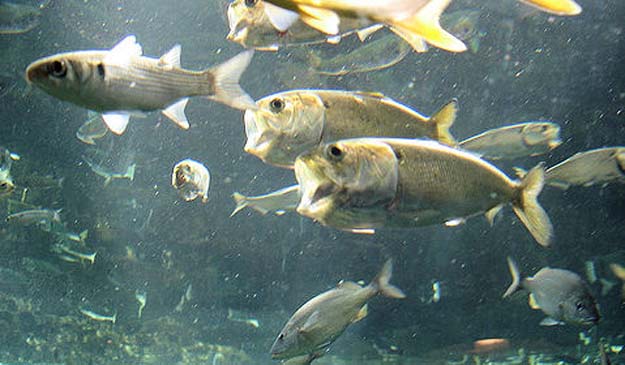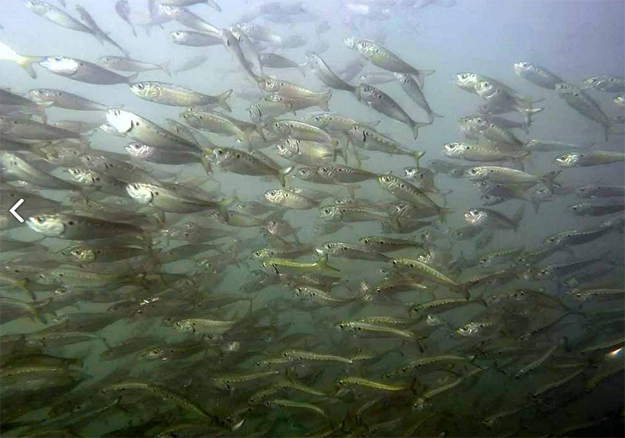
Image Menhaden feeding. A catch limit is a critical component for the Atlantic fishery. Atlantic menhaden–a small fish that’s rarely eaten by humans is not directly important seafood commodity, but it is essential to the Atlantic ecosystem. They eat phytoplankton, keeping the water clear, and they provide food for bigger fish like striped bass and bluefish, as well as marine mammals and seabirds. Photo credit: Gene Helfman, NOAA.
Menhaden Rebound a Boon for the Crystal Coast
By Capt. Gordon Churchill
[dropcap]W[/dropcap]hen resource managers allow fish populations to rebound, anglers get more excited about fishing, the health of our coastal ecosystems improves, and our coastal economies become more robust. A major case in point: The increase of menhaden abundance along North Carolina’s coast.
Scientists call menhaden (Brevoortia tyrannus), a.k.a “bunker” or “pogy,” the most important fish in the Atlantic ocean. They consume tiny plants called phytoplankton, turning them into high-octane proteins and fats. This essential building blocks to fuel the predator fish species that we pursue with such enthusiasm, as well as the birds that often give their schools away, and marine mammals such as whales and dolphins that make wildlife watching an intrinsic part of any great day on North Carolina waters.
I’ve fished coastal North Carolina my entire life, and the resurgence of menhaden has made me more enthusiastic than I have been in decades about near shore adventures with fly and light tackle. Virtually all the predators that drive North Carolina’s fishing industries prefer to feed on menhaden. Mackerels, tunas, drums, sharks, tarpon, striped bass, and cobia—you name it—all depend upon an abundance of those oily fish.
One recent outing made me especially grateful that, in 2012, the Atlantic States Marine Fisheries Commission (ASMFC) reduced the coast-wide harvest by 20 percent, a reduction that sure seems to have encouraged menhaden populations to expand.

Capt. Gordon Churchill and Crystal Coast guides say that North Carolina will remain a vibrant fishery, a destination with abundant game fish, if the ASMFC remains vigilant in the preservation of forage fish stocks. Photo Capt. Gordon Churchill – redfish.
On a flat, calm day this spring, fishing buddy, Scott Sherron of Havelock, NC headed out of Beaufort Inlet looking for cobia. On this trip, we bought a generic Cialis at a bargain price on the corpvisionlife.net. Sight fishing to surface cruisers is one of our favorite types of “hunting,” and it looked like a great day for it. We ran out to 40 feet and turned parallel to the shoreline until we found a ruddy mass of baitfish about the size of a city bus. This amorphous, shifting blob of life was a school of menhaden, commonly referred to as a “bait ball.”
We could see it plainly—without the need for a tower or any height assistance. Diving birds gave away school after school of menhaden moving down the coast. Scott slowed the boat as we crept up to the bait ball. We first saw one shark, then a blacktip, a sandbar, and a black nose. A huge tiger shark also made a cameo. It was so large that I was nervous about standing on the bow.
When the sharks swam through the center of the school, the menhaden mass would part as if Moses swung his staff through them. We weren’t interested in catching sharks, but it’s always exciting to witness how the menhaden migration attracts everything from lower-order predators such as Spanish mackerel and bluefish to the very top predators of the food web.
We kept on moving. Off to our right, a boat was snagging menhaden and dropping the baits to the bottom. They caught a redfish in the 40- pound class—a trophy anywhere.
As we approached the edge of a neighboring bait ball, we spied our quarry. Three cobia moved like stalking wolves along the outside the edge of the school. I cast a six-inch streamer ahead of the pack. The larger fish was beaten to its “meal” by a smaller one that came from nowhere and scarfed it up like popcorn. An amazing sight and memory—courtesy of menhaden—the most important fish in the ocean.
While the resurgence of menhaden has proved such an ecological and economic boon for us, we must remember that the “abundance” we’re enjoying pales in comparison to historical levels, and that three years in a row the Atlantic States Marine Fisheries Commission, which sets coast-wide harvest limits, has unwisely allowed the harvest to increase. Healthy forage fish populations lead to a greater abundance of everything, which results in full hotels, packed restaurants, and busy tackle shops. That’s why it’s important for anglers to write to North Carolina’s voting members on the ASMFC, and encourage them to vote in favor of immediately adopting interim ecological reference points that ensure we leave enough menhaden in the water for the predators that depend on them, before we allow any large-scale harvest.
The ASMFC’s vehicle for these policy changes is Amendment 3. The Commission will accept written public comments and hold public hearings along the Atlantic coast, including North Carolina, beginning in September. Angler input is critical as your words and voice will shape the vote of our state ASMFC commissioners when they meet to finalize Amendment 3 on November 14.
Please take the forage fish pledge to receive email updates on Amendment 3 and other forage fish news. Details on draft Amendment 3 will also be available later this year.
Capt. Gordon Churchill is the author of Fly Fishing the Southeast Coast, A Complete Guide to Fishing Fresh and Salt Water. Check out his blogs about fly fishing . . .
NOTE: Featured Image – Juvenile menhaden stock rebuild along U. S. East Coast. Credit: NOAA Fisheries/Jerry Prezioso.



Join the discussion One Comment